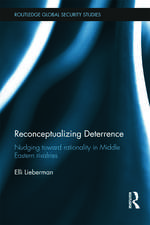Military Transformation Past and Present: Historic Lessons for the 21st Century: Praeger Security International
Autor Mark D. Mandelesen Limba Engleză Hardback – 29 sep 2007 – vârsta până la 17 ani
Din seria Praeger Security International
- 18%
 Preț: 334.19 lei
Preț: 334.19 lei - 8%
 Preț: 335.53 lei
Preț: 335.53 lei - 34%
 Preț: 376.10 lei
Preț: 376.10 lei - 46%
 Preț: 443.64 lei
Preț: 443.64 lei - 29%
 Preț: 240.11 lei
Preț: 240.11 lei - 8%
 Preț: 304.56 lei
Preț: 304.56 lei - 34%
 Preț: 373.82 lei
Preț: 373.82 lei - 19%
 Preț: 412.79 lei
Preț: 412.79 lei - 19%
 Preț: 338.42 lei
Preț: 338.42 lei - 18%
 Preț: 335.62 lei
Preț: 335.62 lei - 27%
 Preț: 377.35 lei
Preț: 377.35 lei - 27%
 Preț: 376.75 lei
Preț: 376.75 lei - 18%
 Preț: 336.46 lei
Preț: 336.46 lei - 18%
 Preț: 321.73 lei
Preț: 321.73 lei - 27%
 Preț: 384.51 lei
Preț: 384.51 lei - 18%
 Preț: 320.50 lei
Preț: 320.50 lei - 18%
 Preț: 320.50 lei
Preț: 320.50 lei - 18%
 Preț: 321.35 lei
Preț: 321.35 lei - 24%
 Preț: 420.54 lei
Preț: 420.54 lei - 14%
 Preț: 335.99 lei
Preț: 335.99 lei - 18%
 Preț: 355.82 lei
Preț: 355.82 lei - 18%
 Preț: 319.83 lei
Preț: 319.83 lei - 18%
 Preț: 334.28 lei
Preț: 334.28 lei - 32%
 Preț: 354.48 lei
Preț: 354.48 lei - 14%
 Preț: 335.14 lei
Preț: 335.14 lei - 38%
 Preț: 405.98 lei
Preț: 405.98 lei - 40%
 Preț: 571.34 lei
Preț: 571.34 lei - 18%
 Preț: 321.85 lei
Preț: 321.85 lei - 18%
 Preț: 323.25 lei
Preț: 323.25 lei - 18%
 Preț: 253.28 lei
Preț: 253.28 lei - 40%
 Preț: 571.50 lei
Preț: 571.50 lei - 14%
 Preț: 333.72 lei
Preț: 333.72 lei - 18%
 Preț: 301.73 lei
Preț: 301.73 lei - 19%
 Preț: 352.96 lei
Preț: 352.96 lei - 26%
 Preț: 387.80 lei
Preț: 387.80 lei - 18%
 Preț: 302.77 lei
Preț: 302.77 lei - 14%
 Preț: 333.91 lei
Preț: 333.91 lei - 17%
 Preț: 325.80 lei
Preț: 325.80 lei - 24%
 Preț: 338.58 lei
Preț: 338.58 lei - 34%
 Preț: 414.73 lei
Preț: 414.73 lei - 18%
 Preț: 354.30 lei
Preț: 354.30 lei - 29%
 Preț: 254.29 lei
Preț: 254.29 lei - 18%
 Preț: 354.11 lei
Preț: 354.11 lei - 18%
 Preț: 334.38 lei
Preț: 334.38 lei - 14%
 Preț: 302.68 lei
Preț: 302.68 lei - 18%
 Preț: 322.97 lei
Preț: 322.97 lei - 27%
 Preț: 376.50 lei
Preț: 376.50 lei - 27%
 Preț: 322.81 lei
Preț: 322.81 lei - 27%
 Preț: 382.91 lei
Preț: 382.91 lei - 18%
 Preț: 320.87 lei
Preț: 320.87 lei
Preț: 375.39 lei
Preț vechi: 494.74 lei
-24% Nou
Puncte Express: 563
Preț estimativ în valută:
71.84€ • 74.58$ • 59.90£
71.84€ • 74.58$ • 59.90£
Carte tipărită la comandă
Livrare economică 22 martie-05 aprilie
Preluare comenzi: 021 569.72.76
Specificații
ISBN-13: 9780275991906
ISBN-10: 0275991903
Pagini: 176
Dimensiuni: 156 x 235 x 21 mm
Greutate: 0.42 kg
Editura: Bloomsbury Publishing
Colecția Praeger
Seria Praeger Security International
Locul publicării:New York, United States
ISBN-10: 0275991903
Pagini: 176
Dimensiuni: 156 x 235 x 21 mm
Greutate: 0.42 kg
Editura: Bloomsbury Publishing
Colecția Praeger
Seria Praeger Security International
Locul publicării:New York, United States
Notă biografică
Mark D. Mandeles is the author of The Future of War: Organizations As Weapons,(2005), Managing Command and Control in the Persian Gulf War (Praeger, 1996), and The Development of the B-52 and Jet Propulsion: A Case Study in Organizational Innovation.
Cuprins
Acknowledgments1 Transformation and Learning in Military Organizations2 Setting the Stage: Learning at the End of the Nineteenth Century3 The Future of Military Aviation between the Wars: The Army and Navy Take Different Paths4 Learning to Conduct Amphibious Landings5 Cooperative Engagement Capability: A Multiorganizational Collaboration6 ConclusionNotesBibliographyIndex
Recenzii
Mandeles seeks to look at military transformations in the past in order to facilitate such transformations in the present and future. He sees military transformation as requiring a number of critical ingredients that taken together explain how military organizations learn...Recommended. Professionals and practitioners.
Mandeles examines previous large-scale changes in military capability and draws inference to current and future questions of military transformation. Early chapters compare how the Navy's aviation planners and the Army Air Corps approached technological and operational uncertainty, and how the U.S. Marine Corps and the Royal Marines developed amphibious operations before WWII. The conclusion lays out a very reasonable argument for keeping the Department of Defense structure multi-organizational, arguing that interaction among groups of organizations enables innovation by enhancing the application of evidence, inference, and tactical knowledge.
The historical sections, which make up most of the book, will appeal to an even broader audience. This book has the strongest possible recommendation for the serious military professional.
Mandeles suggests two audiences for his book: senior military and civilian leaders within the national security establishment and the military analysts who serve them and the public. Both groups would be well served to consider this book and its implications for the future organization of the Department of Defense.
Mandeles examines previous large-scale changes in military capability and draws inference to current and future questions of military transformation. Early chapters compare how the Navy's aviation planners and the Army Air Corps approached technological and operational uncertainty, and how the U.S. Marine Corps and the Royal Marines developed amphibious operations before WWII. The conclusion lays out a very reasonable argument for keeping the Department of Defense structure multi-organizational, arguing that interaction among groups of organizations enables innovation by enhancing the application of evidence, inference, and tactical knowledge.
The historical sections, which make up most of the book, will appeal to an even broader audience. This book has the strongest possible recommendation for the serious military professional.
Mandeles suggests two audiences for his book: senior military and civilian leaders within the national security establishment and the military analysts who serve them and the public. Both groups would be well served to consider this book and its implications for the future organization of the Department of Defense.








